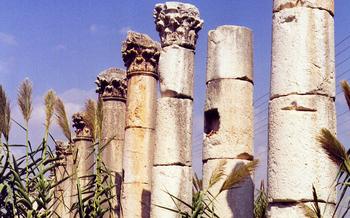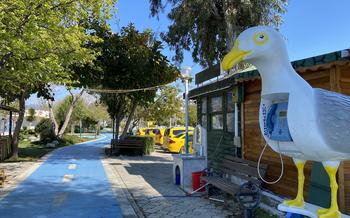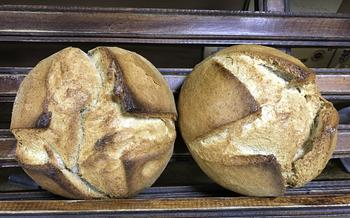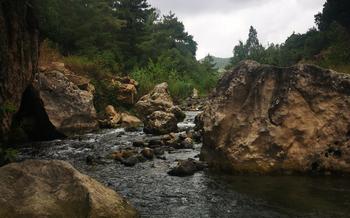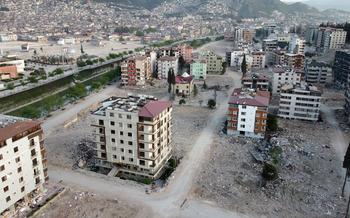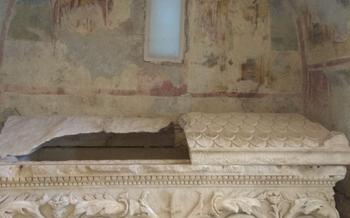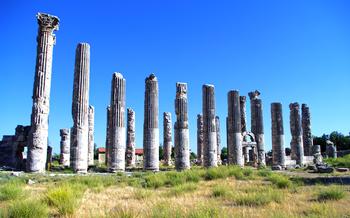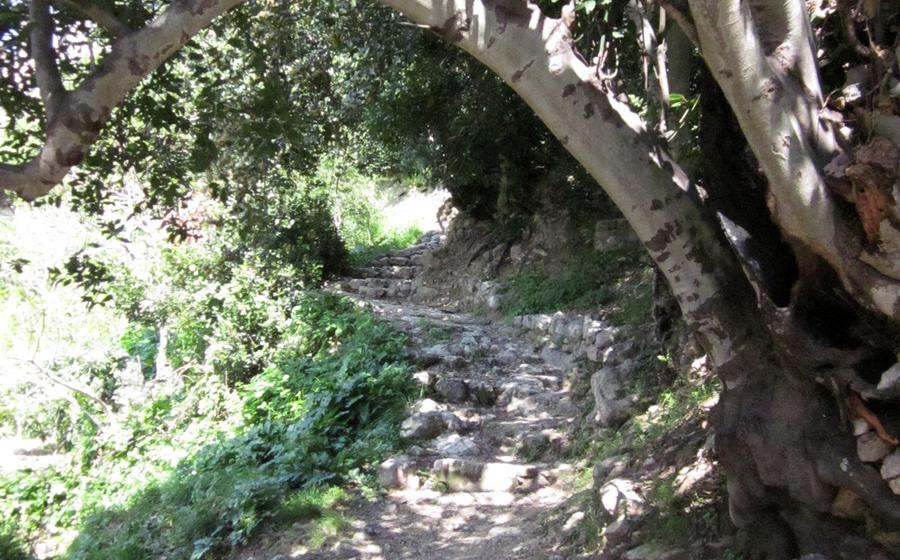
Çevlik Ancient City
- Unveiling a Hidden Gem in Hatay: Çevlik Ancient City
- Exploring the Ruins of Çevlik: A Journey Through Time
- The Temple of Zeus: A Testament to Divine Power
- Çevlik's Mosaics: Masterpieces of Ancient Art
- The Necropolis: A City of the Dead
- A Walk Through History: Çevlik's Ancient Streets
- The Agora: The Heart of Çevlik's Commerce
- The Theater: A Stage for Entertainment and Culture
- The Baths: A Place of Relaxation and Socialization
- The Olive Oil Factory: A Testament to Ancient Industry
- The Museum of Çevlik: A Treasure Trove of Artifacts
- Local Cuisine: Savoring the Flavors of Hatay
- Insider Tip: Unveiling Çevlik's Hidden Secrets
Unveiling a Hidden Gem in Hatay: Çevlik Ancient City
Nestled in the heart of Hatay, Turkey, lies the ancient city of Çevlik, a hidden gem waiting to be explored. Once a thriving metropolis during the Roman and Byzantine periods, Çevlik boasts a rich history and cultural heritage that continues to captivate visitors to this day. As you step into this ancient city, you'll embark on a journey through time, uncovering the secrets of a civilization that once flourished in this region.
Located in the Samandağ district of Hatay, Çevlik is easily accessible by road. Whether you're driving from the city of Hatay or taking a scenic route along the Mediterranean coast, the journey to Çevlik is as rewarding as the destination itself. Once you arrive, prepare to be amazed by the grandeur of this ancient city, with its well-preserved ruins, intricate mosaics, and fascinating history.
During your visit to Çevlik, you'll have the opportunity to explore the ancient city's impressive walls and gates, marvel at the grandeur of the Temple of Zeus, and discover hidden cisterns and aqueducts that once supplied water to this thriving metropolis. As you wander through the ruins, let your imagination run wild as you envision the bustling streets and vibrant atmosphere that once characterized this ancient city.
Exploring the Ruins of Çevlik: A Journey Through Time
The ancient city walls and gates: Çevlik's impressive city walls, which once protected the city from invaders, still stand tall, offering a glimpse into the city's defensive capabilities. Explore the various gates that provided access to the city, each with its unique architectural features and historical significance.
The impressive temple complex: At the heart of Çevlik lies the awe-inspiring temple complex, dedicated to various deities. Marvel at the grand columns, intricate carvings, and well-preserved altars. Imagine the religious ceremonies and rituals that took place within these sacred spaces.
Discovering hidden cisterns and aqueducts: Çevlik's ingenuity is evident in its sophisticated water management system. Discover the hidden cisterns that collected rainwater and the intricate aqueducts that transported water throughout the city. These engineering marvels ensured a reliable water supply, essential for the city's survival.
Unearthing the secrets of the necropolis: Beyond the city walls, explore the vast necropolis, where the dead were laid to rest. Wander amidst the various types of tombs, from simple graves to elaborate mausoleums, each revealing insights into Çevlik's burial practices and beliefs about the afterlife.
The Temple of Zeus: A Testament to Divine Power
At the heart of Çevlik's ancient city lies the awe-inspiring Temple of Zeus, a testament to the city's devotion to the king of the gods. The temple's grand architecture, intricate carvings, and enigmatic history captivate visitors, offering a glimpse into the religious beliefs and practices of ancient Çevlik.
The temple's imposing structure dominates the city's skyline, its towering columns and well-preserved facade hinting at the grandeur it once held. As you approach, the intricate carvings adorning the temple's exterior draw your gaze, depicting scenes from Greek mythology and the exploits of the mighty Zeus. These carvings, a testament to the skill of ancient artisans, bring to life the stories of gods and heroes, offering a glimpse into the religious beliefs and values of Çevlik's inhabitants.
The temple's construction and purpose remain shrouded in mystery, adding to its allure. While its origins are unclear, the temple is believed to have been built during the Hellenistic period, a time when Greek culture and influence permeated the region. The temple's dedication to Zeus, the supreme deity of the Greek pantheon, underscores the city's deep connection to Greek mythology and religious practices.
Beyond its architectural splendor, the Temple of Zeus played a pivotal role in Çevlik's religious ceremonies and festivals. Here, the city's inhabitants gathered to honor Zeus and other deities, offering sacrifices, prayers, and processions. The temple served as a sacred space where the community came together to celebrate religious holidays and express their devotion to the gods.
As you explore the temple's ruins, let your imagination transport you back in time to witness these ancient rituals and ceremonies. Picture the temple adorned with colorful tapestries, the air filled with the scent of incense, and the sound of chanting priests echoing through the grand halls. The Temple of Zeus stands as a testament to the deep religious beliefs that shaped the lives of Çevlik's ancient inhabitants, offering a glimpse into their spiritual world and the enduring power of faith.
Çevlik's Mosaics: Masterpieces of Ancient Art
The ancient city of Çevlik is renowned for its exquisite mosaics, which are considered masterpieces of ancient art. These intricate and colorful mosaics adorn the floors of many buildings throughout the city, depicting a wide range of subjects from mythology to everyday life.
The craftsmanship of the mosaics is truly remarkable, with each tile carefully placed to create detailed and lifelike images. The mosaics feature a variety of motifs, including mythological figures, geometric patterns, and scenes from daily life. Many of the mosaics depict scenes from Greek mythology, such as the battle between Zeus and the Titans or the labors of Hercules.
These mosaics provide a glimpse into the beliefs and values of the ancient people of Çevlik. They also offer insights into the city's economy and trade, as many of the mosaics depict scenes from the marketplace or the harbor.
Preserving these delicate works of art is a significant challenge. Over time, the mosaics have been damaged by earthquakes, looting, and exposure to the elements. Conservation efforts are ongoing to protect and restore these priceless treasures for future generations.
The Necropolis: A City of the Dead
The necropolis of Çevlik is a fascinating and evocative part of the ancient city, offering a glimpse into the funerary customs and beliefs of its former inhabitants. The vast expanse of the necropolis, with its rows upon rows of tombs, is a testament to the city's size and importance.
The tombs themselves vary in size and design, reflecting the social status and wealth of the deceased. Some tombs are simple chambers carved into the rock, while others are elaborate structures with multiple rooms, decorated with intricate carvings and frescoes. The most impressive tombs are the family mausoleums, which often feature grand facades and elaborate interiors.
The necropolis also contains a variety of burial practices. Some bodies were buried in simple pits, while others were placed in stone sarcophagi or cremated and placed in urns. The tombs often contain grave goods, such as jewelry, pottery, and weapons, which provide insights into the lives and beliefs of the deceased.
By studying the necropolis, archaeologists have been able to gain a better understanding of Çevlik's funerary customs and beliefs. The necropolis is not only a place of mourning and remembrance but also a valuable source of information about the city's past.
A Walk Through History: Çevlik's Ancient Streets
Strolling along the ancient streets of Çevlik is like stepping back in time. The well-preserved streets and sidewalks, lined with the remains of shops, houses, and public buildings, offer a glimpse into the bustling life that once filled this city. Imagine the sounds of merchants hawking their wares, the laughter of children playing, and the footsteps of people going about their daily lives.
These streets, which once served as the arteries of Çevlik, provide a fascinating insight into the city's urban planning. The wide main streets, adorned with columns and statues, were designed to accommodate large crowds and facilitate trade. Narrower side streets, lined with smaller shops and workshops, catered to the needs of the local population.
As you explore these ancient streets, you can't help but be struck by the attention to detail and the high level of craftsmanship that went into their construction. The stones used to pave the streets were carefully fitted together, creating a smooth and even surface. The buildings, constructed from local limestone, feature intricate carvings and decorative elements that showcase the skill and artistry of Çevlik's builders.
Walking through these ancient streets is like embarking on a journey through time. Each step you take brings you closer to understanding the daily lives of the people who once called Çevlik home. Whether you're a history buff, an architecture enthusiast, or simply someone who enjoys exploring new places, a stroll through Çevlik's ancient streets is an experience you won't soon forget.
The Agora: The Heart of Çevlik's Commerce
The agora, or marketplace, was the bustling center of Çevlik's economic and social life. This large, open square was surrounded by colonnades lined with shops and stalls selling a variety of goods, from food and clothing to pottery and jewelry. The agora was not just a place of commerce, but also a place for people to gather, socialize, and exchange news and ideas.
The impressive architecture of the agora reflects its importance in the city. The square was paved with large stone slabs and surrounded by a colonnade of Doric columns. The shops and stalls were arranged in neat rows, creating a sense of order and symmetry. The agora also featured a number of public buildings, including a council chamber, a treasury, and a courthouse.
The agora was a hive of activity throughout the day. Merchants from all over the region came to Çevlik to trade their goods. Farmers sold their produce, artisans displayed their wares, and merchants from distant lands brought exotic goods from faraway places. The air was filled with the sounds of haggling, laughter, and the clinking of coins.
The agora was more than just a place of business. It was also a place for people to socialize and exchange news and ideas. People from all walks of life came to the agora to meet with friends, discuss the latest events, and learn about new products and technologies. The agora was a melting pot of cultures and a place where people from different backgrounds could come together and interact.
The Theater: A Stage for Entertainment and Culture
Çevlik's theater is a testament to the city's vibrant cultural life. With its well-preserved tiered seating, it offers a glimpse into the world of ancient entertainment.
Imagine the excitement and anticipation as the audience gathered for performances of plays, music, and other forms of entertainment. The theater's acoustics were designed to carry the actors' voices and the musicians' melodies throughout the auditorium, creating an immersive experience for spectators.
The theater also played a significant role in promoting cultural exchange and artistic expression. Traveling performers brought new ideas and influences to Çevlik, fostering a diverse and dynamic cultural scene.
Whether it was a comedy, a tragedy, or a musical performance, the theater provided a space for the community to come together, celebrate their shared culture, and escape the worries of everyday life.
Today, visitors can still admire the theater's impressive architecture and imagine the lively atmosphere that once filled the air during performances. It is a reminder of the importance of the arts in ancient society and the enduring power of theater to entertain and inspire.
The Baths: A Place of Relaxation and Socialization
Among the impressive ruins of Çevlik, the Roman baths stand as a testament to the city's dedication to relaxation, hygiene, and social interaction. These well-preserved baths offer a glimpse into the daily lives of Çevlik's ancient inhabitants and their pursuit of physical and mental well-being.
The baths were a central part of Roman society, serving not only as places for bathing but also for socializing, exercising, and even conducting business. The remains of the Çevlik baths reveal a complex and sophisticated system of pools, changing rooms, and heating systems, demonstrating the advanced engineering and architectural skills of the Romans.
The baths were typically divided into several sections, each serving a specific purpose. Visitors would first enter the apodyterium, a changing room where they would leave their clothes and belongings. They would then proceed to the frigidarium, a cold plunge pool that helped to cool the body and close the pores after sweating.
Next came the tepidarium, a warm room that prepared the body for the intense heat of the caldarium, the hottest room in the baths. The caldarium was equipped with a raised platform, the laconicum, where bathers could sweat profusely and release toxins from their bodies.
After sweating, bathers would return to the tepidarium to cool down slightly before entering the frigidarium for a final cold plunge. The baths also included a number of other amenities, such as massage rooms, exercise areas, and libraries, catering to the diverse needs of their visitors.
The Çevlik baths played a vital role in promoting physical and mental well-being, providing a place for residents to relax, socialize, and rejuvenate. The rituals and customs associated with bathing were an integral part of Roman culture, and the baths served as a gathering place where people from all walks of life could come together to connect and unwind.
The Olive Oil Factory: A Testament to Ancient Industry
Among the ruins of Çevlik, you'll find a remarkable testament to the city's ancient industry: the olive oil factory. This well-preserved complex offers a fascinating glimpse into the production methods of one of the most important commodities in the Mediterranean world.
The factory consists of a series of interconnected rooms and courtyards, each serving a specific purpose in the oil-making process. Visitors can trace the journey of the olives from the moment they were harvested until they were transformed into the golden liquid that was a staple of the ancient diet.
The factory's most impressive feature is its large stone press, which was used to extract oil from the olives. The press consists of a massive circular stone that was rolled over the olives, crushing them and releasing their precious oil. The oil was then collected in a basin below and stored in large jars for later use.
In addition to the press, the factory also contains other equipment used in the oil-making process, such as grinding stones, storage jars, and lamps. These artifacts provide a tangible connection to the people who worked in this factory centuries ago, and they help us to understand the importance of olive oil in the ancient economy and diet.
A visit to the olive oil factory is a must for anyone interested in ancient industry and agriculture. It's a fascinating glimpse into the lives of the people who lived in Çevlik and a reminder of the importance of this ancient city in the Mediterranean world.
The Museum of Çevlik: A Treasure Trove of Artifacts
The Museum of Çevlik is a treasure trove of artifacts that provides a glimpse into the rich history and culture of the ancient city. Located in the heart of the archaeological site, the museum houses a vast collection of artifacts excavated from Çevlik and its surroundings.
Exhibits in the museum take visitors on a journey through time, showcasing the city's transformation from a small settlement to a thriving metropolis. Visitors can admire intricate pottery, finely crafted jewelry, and impressive sculptures that reveal the artistic prowess of Çevlik's artisans.
One of the highlights of the museum is the collection of mosaics that depict scenes from mythology, günlük yaşam, and religious ceremonies. These intricate artworks offer a glimpse into the beliefs and practices of Çevlik's inhabitants.
The museum also houses a significant collection of coins, providing insights into the city's economic and trade relations. Inscriptions and seals offer tantalizing clues about the political and administrative structure of Çevlik.
A visit to the Museum of Çevlik is a must for anyone who wants to gain a deeper understanding of this ancient city and its enduring legacy. Whether you're a history buff, an art enthusiast, or simply curious about the past, the museum offers a wealth of knowledge and inspiration.
Local Cuisine: Savoring the Flavors of Hatay
A Culinary Journey Through Hatay's Delights
Hatay, the province where Çevlik resides, is renowned for its rich culinary heritage, a blend of Turkish, Arab, and Armenian influences. The region's cuisine is a symphony of flavors, textures, and aromas that will tantalize your taste buds.
Must-Try Dishes
Begin your culinary adventure with Hatay's signature dish, künefe, a crispy shredded filo pastry filled with melted cheese and drenched in sweet syrup. Savor the smoky flavor of şiş köfte, grilled meatballs served on skewers with aromatic spices. Indulge in the tangy goodness of hummus, a creamy chickpea dip topped with olive oil and paprika.
Exploring Local Markets
For an authentic culinary experience, venture into Hatay's vibrant local markets. The air is filled with the scent of freshly baked bread, exotic spices, and ripe fruits. Engage with friendly vendors who will gladly offer samples of their culinary creations.
Hidden Culinary Gems
Uncover hidden culinary gems by venturing beyond the main tourist areas. Ask locals for recommendations on small, family-run restaurants that serve traditional dishes passed down through generations. These hidden gems often offer the most authentic and delicious flavors.
Tips for Navigating Local Cuisine
To fully embrace Hatay's culinary delights, be open to trying new flavors and textures. Don't shy away from street food, as it often offers some of the best and most affordable local dishes. Be sure to try the region's famous künefe, a crispy shredded filo pastry filled with melted cheese and drenched in sweet syrup.
A Culinary Celebration
Hatay's cuisine is a celebration of the region's rich history and cultural diversity. Embark on a culinary journey through Hatay, and savor the flavors that have made this region a foodie's paradise.
Insider Tip: Unveiling Çevlik's Hidden Secrets
Beyond the main attractions of Çevlik, there are hidden gems waiting to be discovered by curious travelers. Venture off the beaten path to explore lesser-known parts of the ancient city and uncover its secrets. Look for the remains of an ancient aqueduct that once supplied water to the city, or stumble upon a hidden cistern that has remained untouched for centuries. Discover the secluded corners of the necropolis, where elaborate tombs and burial chambers tell tales of Çevlik's funerary practices.
To truly immerse yourself in the history of Çevlik, consider hiring a local guide. These knowledgeable individuals can provide unique insights into the city's past and lead you to hidden spots that most tourists miss. They can share stories, legends, and anecdotes that bring the ancient ruins to life, making your visit even more enriching.
For a more intimate and peaceful experience, plan your visit to Çevlik early in the morning or late in the afternoon, when the crowds are smaller. The golden light of sunrise and sunset casts a magical glow on the ruins, creating a breathtaking atmosphere for exploration. As you wander through the ancient streets, imagine the bustling life that once filled them, and let the whispers of history transport you back in time.

